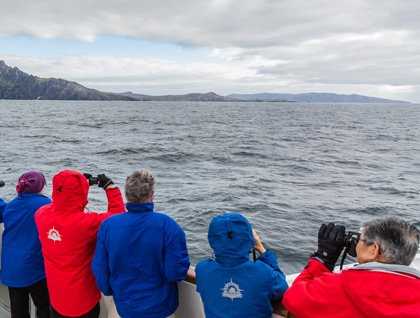Rounding Cape Horn in days of yore, the mere whisper of this place would cause a sailor to pause and then shudder. In the year 1525 a vessel named the San Lesmes was caught in a violent storm on the Atlantic side of the Straits of Magellan and blown south where they thought to see land’s end. In 1578 it was Sir Francis Drake who, after passing safely through the very same strait to the Pacific Ocean as the San Lesmes had attempted, was blown well south of Tierra del Fuego on the Pacific side. The huge expanse of open water Drake encountered brought him to the correct conclusion that Tierra del Fuego was an island, not another continent as had been previously thought. The passage that lies between Cape Horn and the tip of Antarctica bears his name to this day.
This morning National Geographic Explorer approached to within a couple of miles of Isla Hornos, where Cape Horn appeared in very calm and clear conditions. While this island is often quoted as being the southernmost part of South America, that distinction lies with another group of Chilean islands called Islas Diego Ramirez. Throughout the 18th and 19th centuries, rounding the Horn was the only way for clipper ships to transport cargo from Europe to the west coast of North America, Asia or even Australia and New Zealand. With the completion of the Panama Canal in 1914 the need to risk sailors and ships diminished considerably.
Perhaps one of the most intriguing stories of an attempt to round the Horn came with Captain William Bligh of the HMS Bounty in 1788. The ship was not even able to make 100 miles of headway against the prevailing westerly winds in 31 days of trying, so Bligh chose to turn the ship around and sailed east for Africa and the Cape of Good Hope instead!
Later in the day National Geographic Explorer entered the relatively calm and protected waters of the Beagle Channel, that channel which separates the countries of Argentina and Chile. Peale’s and Dusky dolphins didn’t seem to have a national preference as they guided the ship further into the channel by bow-riding, luring us on to our final destination of Ushuaia. Around 5:00 p.m. our local pilot came aboard, safely navigating the ship the final miles to our arrival in port. With the Austral summer solstice less than two weeks away, the lingering warmth of sunset welcomed us to Ushuaia, completing our journey of over 2,000 nautical miles to the White Continent and back again.






